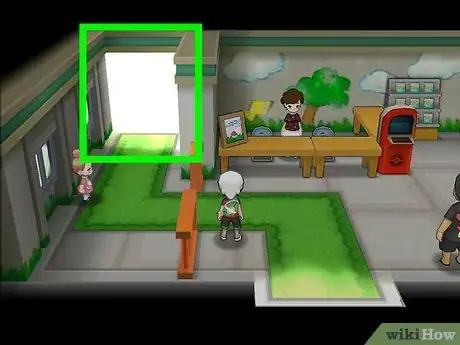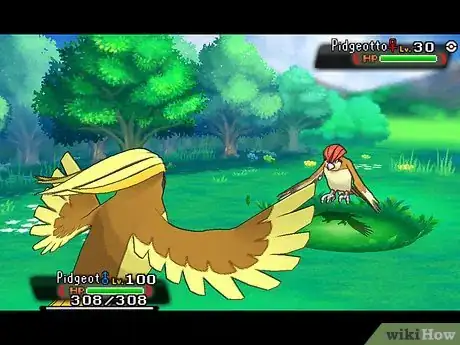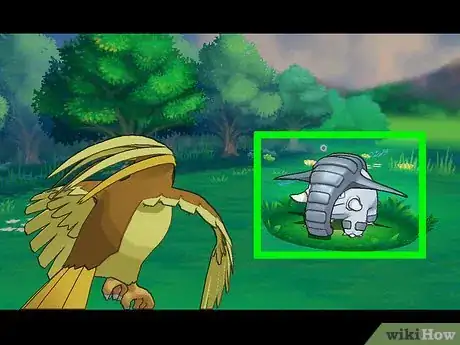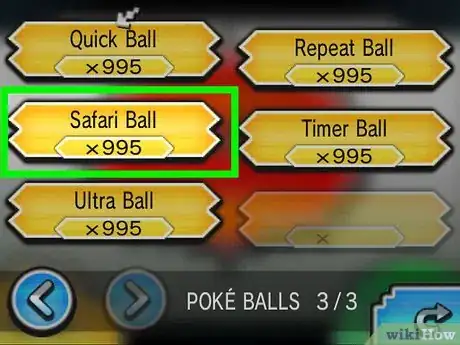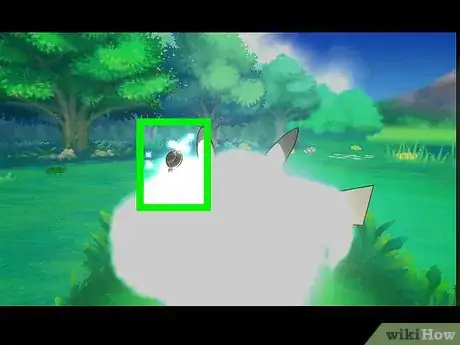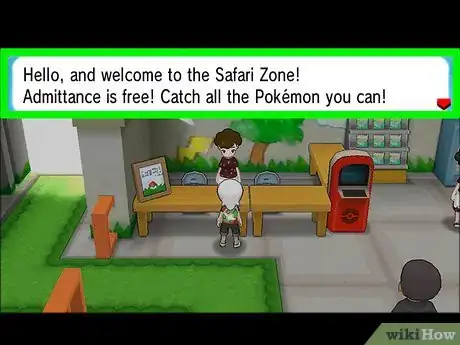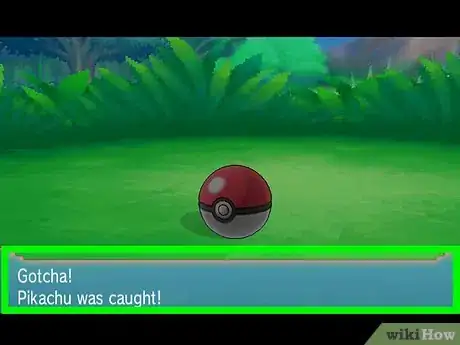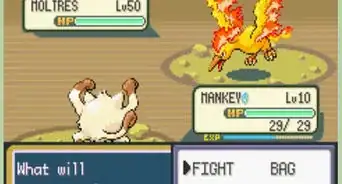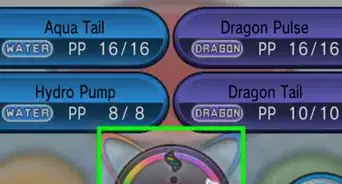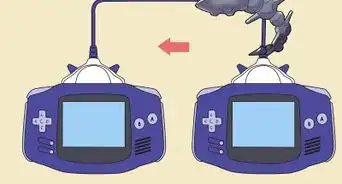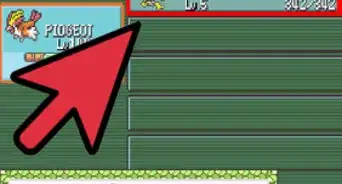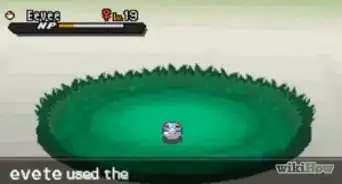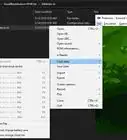This article was co-authored by Madeleine Flamiano. Madeleine Flamiano is a Role-playing Game Enthusiast based in Berkeley, California. She has over 20 years of gaming experience and is an avid gamer in all parts of her life—she's especially fond of tabletop board games and the world of Pokémon. Pokémon Crystal Version is her favorite game in the franchise. Some of her greatest feats were evolving Eevee to a Level 99 Umbreon and collecting every legendary bird Pokémon. Her professional path started at NaNoWriMo, where she scripted a summer-long world-building series and hosted its Virtual Write-Ins. She has written seven books for DDCO Publishing, which specializes in LitRPG and is operated by New York Times Bestseller JA Cipriano. She has ranked in the Top 100 list for Dark Fantasy, Sword & Sorcery, and Fantasy Romance. She was voted by her peers as "The Perfectionist" on Roleplay Adventures, a SERP for forum roleplaying. Madeleine graduated from Mills College with a B.A. in English with a concentration in Literature and a Minor in Philosophy.
This article has been viewed 90,656 times.
In the Pokémon series of games, Safari Zones are special unique areas in each game where rare Pokémon that don't appear anywhere else in the game can be caught. Safari Zones always operate with different rules than the rest of the game world - instead of battling Pokémon in the wild like you normally would, you'll need to carefully use baits and deterrents to get Pokémon to let down their guards so you can catch them. This can be quite challenging, so knowing the ins and outs of Safari Zone mechanics in each game is vital for success.
Steps
Fighting and Capturing Pokémon
-
1Be aware of the modified combat mechanics for the Safari Zone. In the Safari Zone, you'll have four options during battle that work differently than your four "ordinary" options. These new options are: use bait, use a rock, use a safari ball, and run away. In some games, "bait" is referred to as "food" and "rocks" are referred to as "mud" — in both cases, they function identically. In this subsection, we'll briefly review these new combat mechanics.[1]
- Note that the "run away" option functions as normal, so we won't be discussing it.
-
2Use bait to make a Pokémon less likely to run. In the Safari zone, you can't attack the Pokémon you come across, so the main thing determining whether or not you'll be able to capture one is whether the Pokémon runs away. Pokémon in the Safari Zone tend to be more skittish than normal and will sometimes run away after just a few moves. Throwing out some bait makes the Pokémon you encounter less likely to run, buying you more time to catch them.
- However, using bait will also make the Pokémon more difficult to catch in a safari ball. Thus, striking a balance here can be difficult — the longer you get the Pokémon to stick around for, the harder it will be to actually capture it.
Advertisement -
3Use rocks to make a Pokémon easier to catch. On the other side of the coin are rocks: unlike bait, they make the Pokémon you are confronting easier to catch. Since the safari balls you get in the Safari Zone are fairly weak, softening your target up with a rock or two can be a big help when it comes to capturing them.
- However, there's an important downside: using rocks will also make the Pokémon more likely to run away. In fact, after taking more than a few rocks, a Pokémon is virtually guaranteed to run away — some will exit the battle sooner. Thus, once again, using rocks means striking a delicate balance as you try to capture your Pokémon.
-
4Use safari balls to attempt to capture Pokémon. As noted above, you can't use any of the "normal" pokéballs from the rest of the game in the Safari Zone. Instead, you are forced to use safari balls, which are quite weak, especially when dealing with higher-level Pokémon that would be difficult to catch with stronger pokéballs. Unfortunately, there's no easy way to get the most out of your safari balls so generally your best bet is to simply throw one after a rock or two and hope for the best.
- Note that you only have a limited supply of safari balls (depending on the game, usually 30), so save them for Pokémon you want to catch. It's generally the best use of your time to use your safari balls for Pokémon that are only found in the safari zone.
-
5In general, go for capture attempts after one or two rock throws. Unless you're willing to explore the actual math the Pokémon games use to determine whether or not you make a successful capture (more on this below), Safari Zone battles can be a frustratingly inexact science. As a very general rule, your best chances for capturing a Pokémon is generally to throw a safari ball after you've hit the Pokémon with a rock or two. However, be prepared for failure, as Safari Zones can be notoriously difficult even if you maximize your chances for success.
- Note that safari balls are weak compared to the pokéballs you can use in the rest of the game. In addition to this, especially rare Safari Zone Pokémon are extra-difficult to catch.[2] This can lead to some very frustrating situations — for instance, it can easily take 20 or more tries to catch an exceptionally rare Pokémon like Clefairy.
General Tips
-
1Use your limited steps carefully. It's important to understand that you are not allowed to stay in the Safari Zone forever. Instead, you are limited to a certain number of steps while within the zone (even if you're on a bike). When you run out of steps, you are taken out of the zone. This means that you need to plan your path through the zone carefully. Head directly to the area that contains the Pokémon you want to try to capture and use the steps you have remaining solely to capture the Pokémon you want. It is helpful to consult a map of the Safari Zone before entering to plan your trip.
- Bulbapedia, an online user-supported Pokémon encyclopedia, has extensive information about each game's Safari Zone, including maps and guides covering where to look for the Pokémon in each zone. See the Bulbapedia Safari Zone article to get started.[3]
- Note that there is no step limit in the Safari Zone in Pokémon HeartGold and SoulSilver.[4]
-
2Be prepared to pay the entrance fee. It costs in-game money to enter the Safari Zone — not a huge amount, but enough that it bears mentioning. This entrance fee must be repaid every time you enter the Safari Zone. In other words, if your Safari Zone visit ends for any reason, you'll need to pay again the next time you visit.
- Across all of the games in the series, the entrance fee has stayed the same: 500 P. This includes the Great Marsh in Pokémon Diamond/Pearl/Platinum, which is not technically a Safari Zone but behaves very similarly.
- One smart strategy is to save your game before you enter the Safari Zone. This way, if you don't catch any Pokémon you want, you can re-load to avoid paying the entrance fee again.
-
3Consider exploring the math of capture mechanics. In Pokémon, the likelihood of capturing a certain Pokémon when you throw a pokéball is determined by a math equation that takes into account a variety of variables, like its remaining HP, any status effects it is suffering, and more. Avid Pokémon players have analyzed these equations for each game to determine the best ways to catch Pokémon. Though the specifics of every game's equations are too complicated to explore in depth here, a great place to start is Bulbapedia's catch rate article, which has each game's capture equations and a section on how Safari Zone mechanics effect capture rates.
- As an example of the sort of equation used in the games to determine whether certain Pokémon are captured, consider the equation from the Generation games (Gold and Silver):
a = max((3 × HPmax - 2 × HPcurrent) × ratemodified / (3 × HPmax), 1) + bonusstatus
where HPmax is the Pokémon's maximum HP, HPcurrent is the Pokémon's current HP, ratemodified is the catch rate of the Pokémon modified by the ball used (every Pokémon and every ball modifies this in a certain way, and bonusstatus is the modifier for any status condition (sleep and freeze are 10, all others are 0).[5] When you throw a ball, a random number between 0 and 255 is generated. If this number is less than or equal to a, the Pokémon is caught.
- As an example of the sort of equation used in the games to determine whether certain Pokémon are captured, consider the equation from the Generation games (Gold and Silver):
Catching Pokémon in the Kanto Safari Zone
In the following sections, we'll highlight the rare Pokémon in each Safari zone and give specific advice where applicable. To keep these tables to a reasonable size, we've included only the rarest Pokémon in each area — for exhaustive information, consult the Safari Zone guides at Serebii.net and Bulbapedia.
| Area | Directions | Rare Pokémon / Appearance Rate | Notes |
|---|---|---|---|
| Area 1 | This is the area with the entrance to the Safari Zone. | Chansey 1%, Scyther (Red only) 4%, Pinsir 4% (Blue only), Parasect 5%, | |
| Area 2 | Located to the northeast of Area 1. | Kangaskhan 4%, Scyther (Red only) 1%, Pinsir (Blue only) 1%, Parasect 5% | |
| Area 3 | Located to the northwest of the rest house in Area 2. | Tauros 1%, Chansey 4%, Rhyhorn 15%, Dratini 25% | To catch Dratini and the other high-value aquatic Pokémon in this area, use a Super Rod. |
| Area 4 | Located to the south of the northwestern part of Area 3. | Doduo 15%, Exeggcute 20%, Tauros 4%, Kangaskhan 1%, Dratini 25% |
| Area | Directions | Rare Pokémon / Appearance Rate | Notes |
|---|---|---|---|
| Area 1 | This is the area with the entrance to the Safari Zone. | Chansey 1%, Scyther (Red only) 4%, Pinsir 4% (Blue only), Parasect 5%, Dratini 15%, Dragonair 1% | To catch Dratini and the other high-value aquatic Pokémon in this area, use a Super Rod. |
| Area 2 | Located to the northeast of the Area 1. | Kangaskhan 4%, Scyther (Red only) 1%, Pinsir (Blue only) 1%, Parasect 5%, Dratini 15%, Dragonair 1% | |
| Area 3 | Located to the northwest of the rest house in Area 2. | Tauros 1%, Chansey 4%, Rhyhorn 20%, Venemoth 5%, Paras 15%, Dratini 15%, Dragonair 1% | |
| Area 4 | Located to the south of the northwestern part of Area 3. | Doduo 20%, Exeggcute 20%, Tauros 4%, Kangaskhan 1%, Venemoth 5%, Dratini 15%, Dragonair 1% | See above re: aquatic Pokémon. |
Catching Pokémon in the Hoenn Safari Zone
Note that the Generation 4 Hoenn Safari Zone (Omega Ruby/Alpha Sapphire) won't be covered here as the player is allowed to engage in ordinary battles in this zone.
| Area | Directions | Rare Pokémon / Appearance Rate | Notes |
|---|---|---|---|
| Area 1 | This is the area with the entrance to the Safari Zone. | Wobuffet 10%, Doduo 10%, Girafarig 10%, Pikachu 5% | |
| Area 2 | Located to the west of Area 1. | Gloom 5%, Wobuffet 10%, Doduo 10%, Girafarig 10%, Pikachu 5% | |
| Area 3 | Located to the north of Area 2. | Pinsir 5%, Dodrio 5%, Doduo 15%, Gloom 15%, Rhyhorn 30%, Golduck 5% | Golduck requires surfing, not using a fishing rod. |
| Area 4 | Located to the north of Area 1. | Heracross 5%, Natu 15%, Xatu 5%, Phanphy 30% | |
| Area 5 | Located to the east of Area 1. Only available in Emerald after entering the Hall of Fame. | Hoothoot 5%, Spinarak 10%, Mareep 30%, Aipom 10%, Gligar 5%, Snubbull 5%, Stantler 5%, Quagsire 1%, Octillery 1% | Quagsire requires surfing, Octillery requires using a Super Rod. |
| Area 6 | Located to the north of Area 5. Only available in Emerald after entering the Hall of Fame. | Hoothoot 5%, Ledyba 10%, Pineco 5%, Hondour 5%, Militank 5% |
Catching Pokémon in the Sinnoh Great Marsh
Though Sinnoh's Pokémon preserve has a different name, it functions virtually identically to Safari Zones in other regions.
| Area | Directions | Rare Pokémon / Appearance Rate | Notes |
|---|---|---|---|
| All Areas | Quagsire 5%, Gyarados 15%, Whiscash 40% | Aquatic Pokémon in the Great Marsh have the same appearance rates throughout all areas. Quagsire requires surfing; Gyarados and Whiscash require fishing with a Super Rod. | |
| Areas 1 and 2 | Area 1 is located in the northwest of the Great Marsh. Area 2 is located in the northeast. | Azurill 1%, Starly 10%, Budew 10% | Starly and Budew do not appear at night. |
| Areas 3 and 4 | Area 3 is located in the middle west of the Great Marsh. Area 4 is located in the middle east. | Marill 15%, Hoothoot 20%, Quagsire 15%, Wooper 20% | Hoothoot is only available at night. |
| Areas 5 and 6 | Area 5 is located in the southwest of the Great Marsh. Area 6 is located in the southeast of the Great Marsh. | Hoothoot 20%, Marill 15%, Starly 10%, Quagsire 15%, Wooper 20%, Budew 10% | Hoothoot is only available at night. Budew is not available at night |
Catching Pokémon in the Johto Safari Zone
Note that the Safari Zone is not available in Generation 2 (Gold/Silver) but is available in the Generation IV games that visit Johto (HeartGold/SoulSilver). Note also that in this Safari Zone the player can arrange the six different areas in any arrangement desired. Finally, many of the areas in the Johto Safari Zones have Pokémon appearance rates that are not yet known — only data for the known areas has been included. See Bulbapedia for more information.[6]
| Area | Rare Pokémon / Appearance Rate | Notes |
|---|---|---|
| Peak | Vigoroth 10%, Lairon 10%, Zangoose 10%, Spheal 10%, Bronzor 10% | |
| Desert | Spinda 10%, Trapinch 10%, Vibrava 10%, Cacnea 10%, Cacturn 10%, Hippopotas 10%, Carnivine 10% | |
| Plains | Zigzagoon 10%, Lotad 10%, Surskit 10%, Manectric 10%, Zangoose 10%, Shinx 10% |
Warnings
- Once again, the data in the tables above only deals with the most noteworthy Pokémon in each area. In fact, many more Pokémon appear in each Safari Zone.⧼thumbs_response⧽
- Remember — you have a limited number of steps inside the Safari Zone, not a limited amount of time. Thus, you can take as long as you like if you control your movement carefully.⧼thumbs_response⧽
References
- ↑ http://bulbapedia.bulbagarden.net/wiki/Kanto_Safari_Zone
- ↑ http://strategywiki.org/wiki/Pok%C3%A9mon_Red_and_Blue/Safari_Zone
- ↑ https://bulbapedia.bulbagarden.net/wiki/Safari_Zone
- ↑ https://bulbapedia.bulbagarden.net/wiki/Johto_Safari_Zone#Areas
- ↑ https://bulbapedia.bulbagarden.net/wiki/Catch_rate#Capture_method_.28Generation_II.29
- ↑ https://bulbapedia.bulbagarden.net/wiki/Johto_Safari_Zone#Areas
